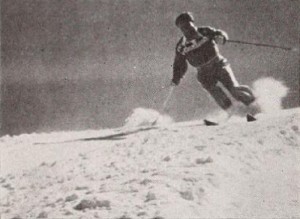
"A Ski Story, by Albert E. Sigal, has been two years in the making — but it has been well worth the effort. Laid against the scenic grandeur of Yosemite National Park, the picture is eloquent testimony both to the thrills and the dynamic beauty of the sport of skiing. Mr. Sigal begins his story slowly with an introductory sequence which sets the mood of the piece. Sequences then follow in leisurely progression of the activities of the ski school, the joys of a hot lunch served alfresco beside the clubhouse, down mountain racing and cross country rambling. Mr. Sigal's consistently good color cinematography benefits to a degree by the clarity of the Western air, a boon so often denied to skiing movie makers on Eastern slopes." Movie Makers, Dec. 1943, 477.
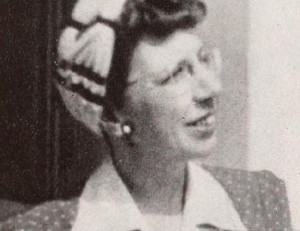
"Behind the Scenes was filmed by Mildred J. Caldwell while the Long Beach Cinema Club was making Fire From the Skies, a civilian defense movie. This production skillfully presents an entertaining record of the problems and the confusion that beset amateur motion picture activities, and it shows how a successful picture can be produced in spite of them." Movie Makers, Dec. 1943, 477.
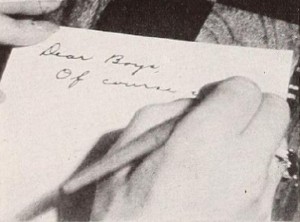
"Dear Boys is a personal motion picture which might have been made in many an American home this past year. Looking about him, C. Manley DeBevoise found his two sons in the Army and his once lovely flower garden changing into a Victory vegetable patch, well tended but mundane. It was from these materials, mixed with imagination and technical competence, that Mr. DeBevoise compiled his film. Mother is discovered (as the picture begins) writing the familiar greeting to her service sons. Her comments during the course of the letter provide the subtitles and the continuity for this attractive record of domestic doings, while Mr. DeBevoise's carefully sequenced scenes tell the story. Dear Boys is simple, sincere and a family film story which any movie maker would be proud to produce — and to own." Movie Makers, Dec. 1943, 477.
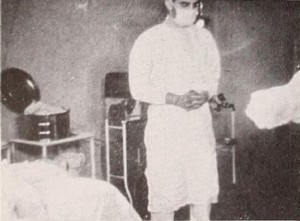
"Dr. Robert Mallory, III, offers another of his brilliant surgical movies. This very able filmer, who has brought his hobby to the service of his profession, studies the course of a childbirth in which grave complications are found. The operation is recorded very intelligently, and to the enforced continuity that the event itself makes necessary are brought closeups and varying camera positions, wherever these are possible. The value of this type of cinematography to surgeons who work alone in small communities is incalculable. When it exists at all, it is highly serviceable; when it is as well done as Dr. Mallory has done it, it is a very direct contribution to the art of healing. Dr. Mallory, in this film, makes a very clarifying use of a model, to show the misplacement of the child and some of the delivery technique, thus giving information that the camera could not otherwise have presented." Movie Makers, Dec. 1943, 477.
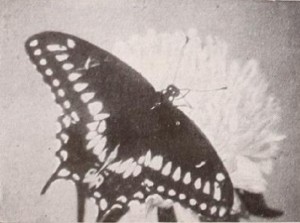
"Butterflies are John Larson's subject in this carefully planned and filmed record of the life cycle of the lepidoptera which are the Frail Children of the Sun. We are shown the beauty of the highly colored flower visitors and their varied and geometrically startling decorativeness, in footage of comforable length which fixes our interest on the movie's main topic. This is then elaborated in sequences that are not only excellently recorded in Kodachrome, but that give real information about the brief but eventful existence of the butterfly through its various incarnations. The film ends with more footage of the beauty of the summer and of the butterflies that add to that beauty." Movie Makers, Dec. 1943, 477-478.
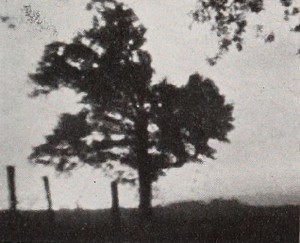
"Holiday with the Heavers is one of those rare films that display sincere artistic sensitivity that is manifestly not the product of technical skill nor the "slick" application of the rules of composition and film planning. It is a picture that promises that its maker — Dr. W. Lynwood Heaver — with more cinematic experience, might produce the finest type of amateur motion picture. Holiday with the Heavers is not a record of a family jaunt, as its title would imply. Rather, it is a scenic study of fall, enlivened by the presence of a three year old who investigates a park and explores the autumn leaves. Included in the film are beautiful and eerie shots of the late fall, effective silhouettes and charming closeups of the small actor." Movie Makers, Dec. 1943, 478.
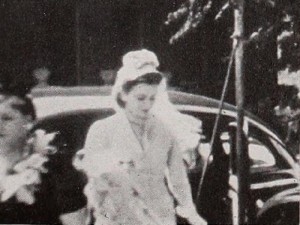
"Although Made in Heaven, by Jesse Geisler, is a carefully planned and sequenced film of the preparations for a wedding and the wedding itself, it gives the effect of complete realism, tinctured with good humor and the joy of life. The preparations are gay, as the bride's friends help her to dress, producing "something old, something new, something borrowed and something blue" in the traditional way. The Jewish orthodox ceremony is handled with simple dignity and then, with the section presenting the wedding party, the film resumes its lighter treatment. Transitions from one sequence to another are excellently handled, and the scenes of the wedding party represent an outstanding accomplishment, for it is not easy to make good movies at such an occasion." Movie Makers, Dec. 1943, 478.
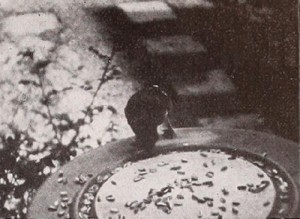
"Our Boisterous Bluejays is a remarkable study of bird life, filled with intimate shots that are among the best ornithologic cinematography on record. Mrs. Warner Seely, who produced this film, has become an expert at picturing birds in their natural habitat, and she shows the bluejay at every stage of development." Movie Makers, Dec. 1943, 478.
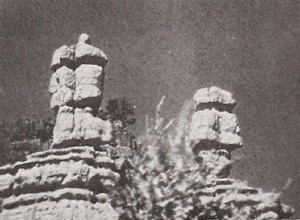
"Parks of Paradise was originally intended as a 2000 foot pictorial travelog that would cover every national park and monument in the United States, but travel conditions enforced a limitation, so Norris Smitley has confined the scope to include only the national parks of the Southwest, permitting a more detailed presentation of the material used. Many unusual scenes of popular subjects are shown in the picture, which is further distinguished by beautiful color and meticulous cinematography." Movie Makers, Dec. 1943, 478.
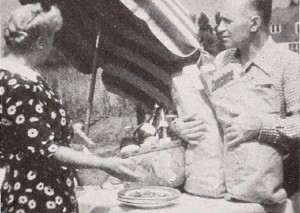
"George Mesaros, who has demonstrated his competence as a maker of good movies in other fields, turns to humor in this film comment on wartime conditions. The point of the story — for it is the foray and not the tale that is pointless — turns on providing for a picnic in the yard of the home. While the master of the house is shopping with ration points, the skeptical family gets, from the Victory garden, cooks and eats the alfresco feast, at the end of which Father — who really did find something in the shops — returns with loaded arms. First class Kodachrome pictures and a well knit continuity are used by Mr. Mesaros to bring to American audiences something of the spirit of easy and natural outdoor fun with food that for so long characterized the Europe of happy memory. Some of the scenes of cooking are so realistic that one almost reaches for what is shown on the screen." Movie Makers, Dec. 1943, 478.
Total Pages: 299